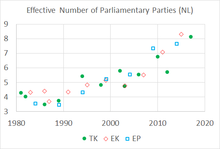Effective number of parties
The effective number of parties is a concept introduced by Laakso and Taagepera (1979)[1] which provides for an adjusted number of political parties in a country's party system. The idea behind this measure is to count parties and, at the same time, to weight the count by their relative strength. The relative strength refers to their vote share effective number of electoral parties (ENEP) or seat share in the parliament effective number of parliamentary parties (ENPP). This measure is especially useful when comparing party systems across countries, as is done in the field of political science.[2] The number of parties equals the effective number of parties only when all parties have equal strength. In any other case, the effective number of parties is lower than the actual number of parties. The effective number of parties is a frequent operationalization for the political fragmentation.

There are two major alternatives to the effective number of parties-measure.[3] John K. Wildgen's index of "hyperfractionalization" accords special weight to small parties.[4] Juan Molinar's index gives special weight to the largest party.[5] Dunleavy and Boucek provide a useful critique of the Molinar index.[6]
The measure is essentially equivalent to the Herfindahl–Hirschman index, a diversity index used in economics; the Simpson diversity index, which is a diversity index used in ecology; and the inverse participation ratio (IPR) in physics.
Formulae
According to Laakso and Taagepera (1979), the effective number of parties is computed by the following formula:
where n is the number of parties with at least one vote/seat and the square of each party's proportion of all votes or seats. The proportions need to be normalised such that, for example, 50 per cent is 0.5 and 1 per cent is 0.01. This is also the formula for the inverse Simpson index, or the true diversity of order 2.
An alternative formula proposed by Golosov (2010)[7] is
which is equivalent – if we only consider parties with at least one vote/seat – to
Here, n is the number of parties, the square of each party's proportion of all votes or seats, and is the square of the largest party's proportion of all votes or seats.
Values
The following table illustrates the difference between the values produced by the two formulas for eight hypothetical vote or seat constellations:
| Constellation | Largest component, fractional share | Other components, fractional shares | N, Laakso-Taagepera | N, Golosov |
|---|---|---|---|---|
| A | 0.75 | 0.25 | 1.60 | 1.33 |
| B | 0.75 | 0.1, 15 at 0.01 | 1.74 | 1.42 |
| C | 0.55 | 0.45 | 1.98 | 1.82 |
| D | 0.55 | 3 at 0.1, 15 at 0.01 | 2.99 | 2.24 |
| E | 0.35 | 0.35, 0.3 | 2.99 | 2.90 |
| F | 0.35 | 5 at 0.1, 15 at 0.01 | 5.75 | 4.49 |
| G | 0.15 | 5 at 0.15, 0.1 | 6.90 | 6.89 |
| H | 0.15 | 7 at 0.1, 15 at 0.01 | 10.64 | 11.85 |
Institutional theory
The effective number of parties can be predicted with the seat product model[8][9] as , where M is the district magnitude and S is the assembly size.
Effective number of parties by country
For individual countries the values of effective number of number of parliamentary parties (ENPP) for the last available election is shown.[10] Some of the highest effective number of parties are in Brazil, Belgium, and Bosnia and Herzegovina. European Parliament has an even higher effective number of parties if national parties are considered, yet a much lower effective number of parties if political groups of the European Parliament are considered.
References
- ^ Laakso, Markku; Taagepera, Rein (1979). ""Effective" Number of Parties: A Measure with Application to West Europe". Comparative Political Studies. 12 (1): 3–27. doi:10.1177/001041407901200101. ISSN 0010-4140. S2CID 143250203.
- ^ Lijphart, Arend (1999): Patterns of Democracy. New Haven/London: Yale UP
- ^ Arend Lijphart (1 January 1994). Electoral Systems and Party Systems: A Study of Twenty-seven Democracies, 1945–1990. Oxford University Press. p. 69. ISBN 978-0-19-827347-9.
- ^ "The Measurement of Hyperfractionalization". Cps.sagepub.com. 1971-07-01. Retrieved 2014-01-05.
- ^ Molinar, Juan (1 January 1991). "Counting the Number of Parties: An Alternative Index". The American Political Science Review. 85 (4): 1383–1391. doi:10.2307/1963951. JSTOR 1963951. S2CID 154924401.
- ^ Dunleavy, Patrick; Boucek, Françoise (2003). "Constructing the Number of Parties". Party Politics. 9 (3): 291–315. doi:10.1177/1354068803009003002. S2CID 33028828.
- ^ Golosov, Grigorii V. (2010). "The Effective Number of Parties: A New Approach". Party Politics. 16 (2): 171–192. doi:10.1177/1354068809339538. ISSN 1354-0688. S2CID 144503915.
- ^ Taagepera, Rein (2007). "Predicting Party Sizes". Oxford University Press
- ^ Li, Yuhui; Shugart, Matthew S. (2016). "The Seat Product Model of the effective number of parties: A case for applied political science". Electoral Studies. 41: 23–34. doi:10.1016/j.electstud.2015.10.011.
- ^ "Election indices dataset, Gallagher, Michael, 2021". Archived from the original on 2022-10-06. Retrieved 2022-09-05.
External links
- Michael Gallagher providing data on the Laakso-Taagepera effective number of parties for over 900 elections in over 100 countries
- Average effective number of parties (Golosov) for 183 democratic party systems and non-systems, 1792–2009, reported in Golosov, Grigorii V., "Towards a Classification of the World's Democratic Party Systems, Step 1: Identifying the Units", Party Politics, Vol. 19, No. 1, January 2013, pp. 134–138.
- How to compute Golosov’s effective number of parties in Excel






